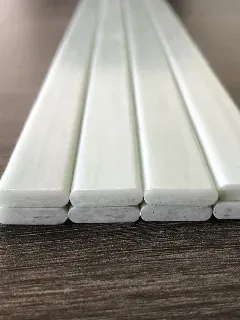loading...
- No. 9, Xingyuan South Street, Dongwaihuan Road, Zaoqiang County, Hengshui, Hebei, China
- admin@zjcomposites.com
- +86 15097380338
- Welcome to visit our website!
Mechanics and Design of Reinforced Concrete Utilizing FRP Bars for Enhanced Performance
Reinforced Concrete with FRP Bars Mechanics and Design
Reinforced concrete is a composite material that combines the compressive strength of concrete with the tensile strength of reinforcement materials to achieve structures that can withstand various loads. Traditionally, steel bars (rebar) have been the reinforcement material of choice, providing the necessary tensile strength. However, advances in materials science have led to the development of Fiber Reinforced Polymer (FRP) bars, which offer unique advantages over conventional steel reinforcement. This article will delve into the mechanics of reinforced concrete with FRP bars and the design considerations for utilizing these materials in construction.
Mechanics of Reinforced Concrete with FRP Bars
FRP bars are made of polymer matrices reinforced with fiber materials such as glass, carbon, or aramid. This composition confers a series of benefits over traditional steel bars, including high strength-to-weight ratios, corrosion resistance, and non-magnetic properties. These characteristics make FRP bars particularly suitable for specific environments where steel reinforcement might suffer degradation.
When it comes to the mechanics of reinforced concrete with FRP bars, it is essential to understand how these bars interact with concrete under various stress conditions. The bond between FRP and concrete plays a critical role in load transfer. Typically, FRP bars exhibit a different bond behavior compared to steel due to their smooth surface texture and lower Young's modulus. Consequently, engineers must account for the bond strength when designing structures, ensuring that the transfer of forces between the FRP bars and surrounding concrete is effective.
One of the key mechanical properties of FRP bars is their tensile strength, which is substantially higher than that of steel. However, their lower modulus of elasticity implies larger elastic deformations under load. Designers must consider this aspect, as it can influence the deflection and crack formation in concrete members. Additionally, the failure modes of FRP-reinforced concrete can differ from those of traditional reinforced concrete, often resulting in sudden and brittle failure. As such, understanding these mechanics is crucial for ensuring the structural integrity and safety of constructions employing FRP bars.
Design Considerations
reinforced concrete with frp bars mechanics and design

The integration of FRP bars into concrete design introduces new challenges and considerations. First and foremost, engineers must be aware of the material properties of the specific FRP being used. Different types of fibers can lead to variations in mechanical performance, thermal behavior, and durability. As a result, accurate material characterization is essential to achieve optimal design outcomes.
Furthermore, the design approach for FRP-reinforced concrete structures must include adjustments for the unique behavior of FRP. For example, the compatibility of thermal expansion between FRP bars and concrete should be taken into account to mitigate potential issues related to temperature changes. This aspect is particularly pertinent in areas with significant temperature fluctuations, as differing expansion rates can lead to internal stresses and, ultimately, structural failure.
Another crucial design aspect involves adherence to relevant codes and standards, as regulatory frameworks for the use of FRP in construction continue to evolve. Standards such as ACI 440 for the design and construction of concrete structures using FRP reinforcement provide essential guidelines and recommendations that must be followed to ensure safety and reliability.
Additionally, serviceability limits, such as deflection and crack control, must be considered during the design phase. The larger deformations associated with FRP bars necessitate adequate provision for serviceability to prevent overstressing the concrete and controlling crack widths.
Conclusion
Reinforced concrete structures utilizing FRP bars represent a significant innovation in construction materials and methods. With their unique mechanical properties, FRP bars enhance the performance of concrete under various loading conditions, particularly in corrosive environments or where reduced weight is advantageous. However, the mechanics of this hybrid material system and the corresponding design considerations present new challenges that engineers must navigate.
As the understanding of FRP materials continues to grow and is supported by ongoing research and field trials, the potential for widespread use of FRP bars in reinforced concrete applications is substantial. Engineers and designers must remain informed about the latest developments to harness the benefits of this technological advancement effectively, ensuring the safety, durability, and sustainability of future concrete structures.
-
The Rise of FRP Profiles: Strong, Lightweight, and Built to LastNewsJul.14,2025
-
SMC Panel Tanks: A Modern Water Storage Solution for All EnvironmentsNewsJul.14,2025
-
GRP Grating: A Modern Solution for Safe and Durable Access SystemsNewsJul.14,2025
-
Galvanized Steel Water Tanks: Durable, Reliable, and Ready for UseNewsJul.14,2025
-
FRP Mini Mesh Grating: The Safer, Smarter Flooring SolutionNewsJul.14,2025
-
Exploring FRP Vessels: Durable Solutions for Modern Fluid HandlingNewsJul.14,2025
-
GRP Structures: The Future of Lightweight, High-Performance EngineeringNewsJun.20,2025
